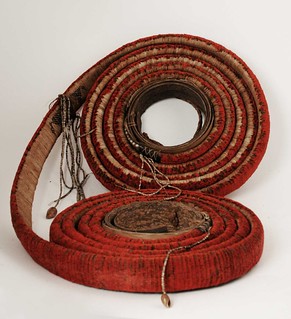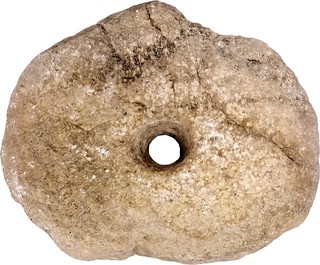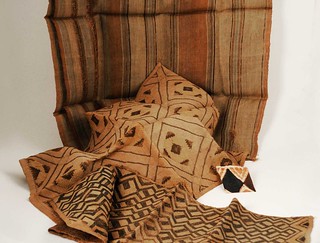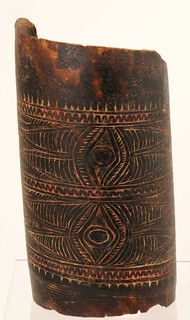
PREV ARTICLE
NEXT ARTICLE
FULL ISSUE
PREV FULL ISSUE
STACK'S BOWERS ANA PRIMITIVE MONEY HIGHLIGHTSHere are more Stack's Bowers highlights - these are more lots from an Advanced Collection of Primitive Monies in the firm's 2018 American Numismatic Association World's Fair of Money sales. -Editor
Lantaka Dutch Cannon Money 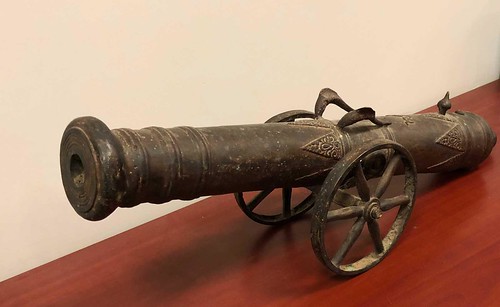
MALAYA. Lantaka Dutch Cannon Money, ND (ca. 16th to Early 20th Century). Approximately 32 inches in length, approximately 7 inches wide wheel to wheel; Approximately 13 lbs. Opitz-pg. 100; Quiggin-Fig.116. RARE. Dutch East Indies monogram "VOC" near base. Triangular shaped boarder near base and near wheels depicting a floral design. Two engraved handles on top near wheels. Used in several locations such as Brunei, Sabah and Sarawak and other parts of south east Asia. These cannons were made of various metals including bronze, brass, copper, iron and other metals. Valued by weight at $25-$30 a Picul, they were used for a multitude of purposes such as "Bride Price" or wedding and engagement ceremonies, trading purposes, barter of goods, payment of fines and in the purchase of slaves (a slave being valued in Piculs of brass guns). During World War II many were melted down which accounts for their rarity today. Minor earthen deposits with an attractive patina.
To read the complete lot description, see:
Falus Bronze Casting Tree 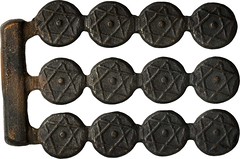
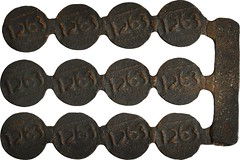
Morocco. Falus Bronze Casting Tree, AH 1263 (1846/7). Moulay 'Abd al Rahman (AH 1238-76 (1822-59)). C-122a.1 (for basic type). Complete Falus, second standard, casting tree. Each bears the seal of Solomon with the AH date 1263, no mint mark. Usually found as single coins in less than desirable condition VERY RARE to obtain a complete tree. Quite interesting and highly sought after as a complete tree. Deeply toned and attractive.
To read the complete lot description, see:
Honey Eater Bird Feather Coil SOLOMON ISLANDS. Santa Cruz. Honey Eater Bird Feather Coil, ND.
The value placed on each coil was dependent on its integrity and graduated in value from a new or nearly perfect coil (#1) to the bottom (#10) which was nearly worn out and blackened from feather loss. For example it would take two #10's to equal one #9 and two #9's to equal a #8. So a #1 was equal to 512 #10's. According to Opitz in 1962, there were only five men on Santa Cruz who could bind currency. A person may learn this skill only if his father was also a currency binder. The binder needs the inheritance of magic secrets; an unauthorized person making his own currency risks the anger of the spirits. Areas of missing feathers which are now blackened. Based on the amount of feathers still present on this example we believe it to be a about a #2 or #3. Highly sought after and a real treat for the specialist of primitive monies or ethnography.
To read the complete lot description, see:
Yap Island Stone Money Yap Island. Stone Money "Fei" & Banana Fiber and Hibiscus Fiber Mat, ND (ca. Late 19th Century or Earlier). Pre O'Keefe Type.
As there is no large source of stone on Yap, the stones were quarried and shaped on the island of Malakal in Palau, then shipped back to Yap on native boats. The stones are made of calcite, which is abundant on Malakal. Some of the larger stones took as long as two years to quarry and shape using axes made from giant clams. The trip from Malakal to Yap via boat was a hazardous voyage that claimed many lives. Often the value placed on a stone directly related to the amount of human lives lost in order to quarry it and deliver to Yap. Although there are many sizes and shapes of Yap stones, they can be classified into two basic types: pre and post O'Keefe. The earliest stones were produced by the locals using axe heads made from segments of the giant clam. Later stones or "O'Keefe stones" were produced in the late 1800's using metal tools. David O'Keefe was American of Irish heritage who came to Yap with tools and a junk boat acquired in Hong Kong, which he used to quarry and transport "Fei" from Malakal to Yap, and through this process set himself up as the King of Yap Island. The 1954 motion picture "His Majesty O'Keefe" starring Burt Lancaster, although somewhat dramatized and engrossed, fairly accurately portrays this series of events. The stone offered here is the pre O'Keefe type. Seldom are larger stones available for sale as removing them from the island was extremely hard due to their size and weight. This example is quite nice to behold and was quite well produced considering it was hewn by hand. In color it is a lovely milky golden tan. Simply a delight to behold. Often referred to as the key or "Holy Grail" to assembling a collection of primitive money the chance to obtain one of these pieces should not be missed.
A classic. I've never seen the "His Majesty O'Keefe" movie - what do readers think of it? -Editor
To read the complete lot description, see:
Elephant Tail Hair Money 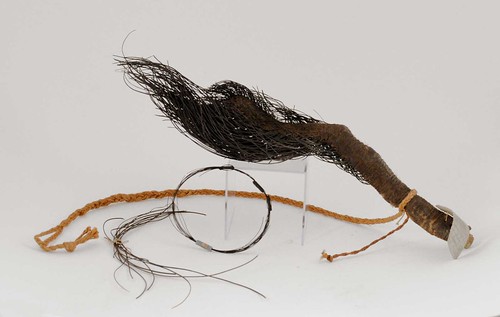
Africa. Congo, Kenya & French Cameroon. Elephant Tail Hair Money, ND (ca. 19th Century). Tail approximately 20 in length, bundle of strands of varying lengths and bracelet approximately 5 inches in diameter. Opitz-pg. 139/40. 3 pieces in lot. Each piece in lot with early provenance such as lot tags and old collectors ticket. Lot includes a full tail, a bracelet and a bundle of individual hairs. The full tail is EXTREMELY RARE and extremely difficult to obtain. The whole tail as well as the individual hairs from the tail were used as money. At one point 600-700 strands were worth one slave and later one full tail was worth 2-3 slaves. It was also believed that the hairs prevented disease. In Durant Lopy's book "Kingdom of Congo" published 1880, he described how natives would drive elephants down narrow trails as it was difficult for them to turn around. The natives would sneak up behind the elephants, cut off their tails and run away before the elephant could turn around. The bracelet was sent to Mrs. H. H. Quiggin from Kenya and has a bead on it.
I remember one of these hanging on the wall of Gordon Dodrill's tiny coin shop in Downtown Pittsburgh. It creeped me out then, too. -Editor
To read the complete lot description, see:
Iron Spearhead Money 
CONGO. Liganda "Doa" Iron Spearhead Money, ND (ca. 19th to 1920's). Approximately 9.1 ft (110 inches) x 10.25 in at the widest point; Approximately 823.48 gms (1 lbs 14 oz). Opitz-pg. 203; Quiggin-pg. 64. Made from iron by the Turumba used in bride price and to buy canoes. The Topoke of the Lomami valued a male slave at 30 Liganda and a female slave from 40 to 100 in 1907. By 1920 they were valued at about five Belgian Francs. Signs of rust as would be expected, but intact. Overall a handsome and interesting large example of sure to excite the specialist of Primitive monies.
To read the complete lot description, see:
Beetle Wing Strands & Beetle Leg Money PAPUA NEW GUINEA. Beetle Wing Strands & Beetle Leg Money, ND.
I've never seen one of these before. Today's cheap full color photography brings these items to life like never before. -Editor
To read the complete lot description, see:
Trade Cloth Africa. Angola, Belgian Congo & Benin. Trade Cloth, ND (ca. 19th Century).
Also included are several smaller pieces of cloth from various locations two of which look to be of a more modern manufacture and one from Papua New Guinea (approximately 3 x 3 in). Overall well preserved with minimal deterioration, one of the small cloths has moth holes. Other defect may be present. Close personal inspection is advised and will reward the diligent bidder. Several pieces are from old Hans M.F. Schulman auctions with undated auction flips and one from an old NASCA auction.
To read the complete lot description, see:
Pacific Rim Primitive Monies 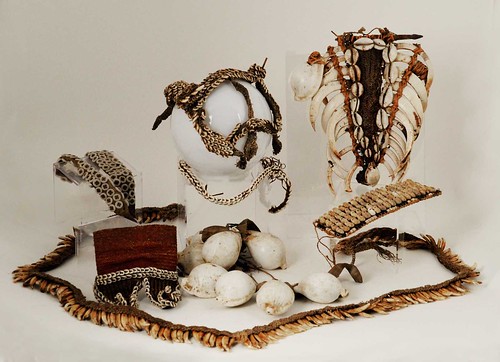
PACIFIC RIM. Papua New Guinea, Admiralty Islands, Guadalcanal, San Cristobal, Manus Province. Dog Teeth, Shell Ornaments and Buttons, ND (ca. 19th to early 20th Century). 10 pieces in lot. Comprised of a selection of necklaces and ornaments of dog teeth, various shells and buttons. Included are a six foot long(approximately) necklace of dog teeth(Opitz-pg. 132/33), a five foot long (approximately) necklace adorned with shells and dog teeth(Opitz-pg. 132/33), a headdress adorned with olive shells and dog teeth, a strand of Nassa shells(Optiz-pg. 337), a woven fiber arm band adorned with olive shells, a small mat with beaded border and 76 cowrie shell tied in four rows of 19, a belt of 8 large cowrie shell attached, a band of buttons 28 in long(approximately) and a boar tusk breast plate with small to large cowries. Mostly used in bride price, but also used for other transactions such as buying slaves and other necessities. Some show signs of use, chipping, cracks, missing shells and/or other defects. Close personal inspection is advised and will reward the diligent bidder. An interesting gathering giving a glimpse into the ingenuity of the Pacific islands.
To read the complete lot description, see:
Tortoise-Shell Armband Money
Approximately 7.75 x 4.75 in; 185.26 gms. Opitz-pg.235. Ornately carved symmetrical design colored with red and yellow pigment. These tortoise shells were imported from Papua New Guinea and were used as currency and were the principal item in bride price. Very interesting and RARE and highly sought after. Much pigment still intact. Lovely patina.
To read the complete lot description, see:
I always thought it would be fun to have a contest for the best made-up primitive money names. Sort of Mad Libs crossed with a Chinese menu - one each at random from columns A, B, and C, like: Brazilian Coffee-Bean Cluster money or South Tongan Tiki Bird Snot money. No real names, please, although it might also be fun to pick the fake one from a group of real names, or the one real one from a group of convincing fakes. -Editor 
Wayne Homren, Editor The Numismatic Bibliomania Society is a non-profit organization promoting numismatic literature. See our web site at coinbooks.org. To submit items for publication in The E-Sylum, write to the Editor at this address: whomren@gmail.com To subscribe go to: https://my.binhost.com/lists/listinfo/esylum All Rights Reserved. NBS Home Page Contact the NBS webmaster 
|
